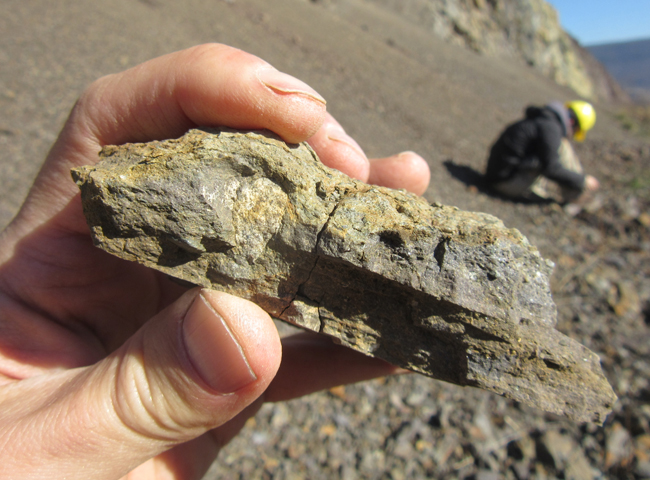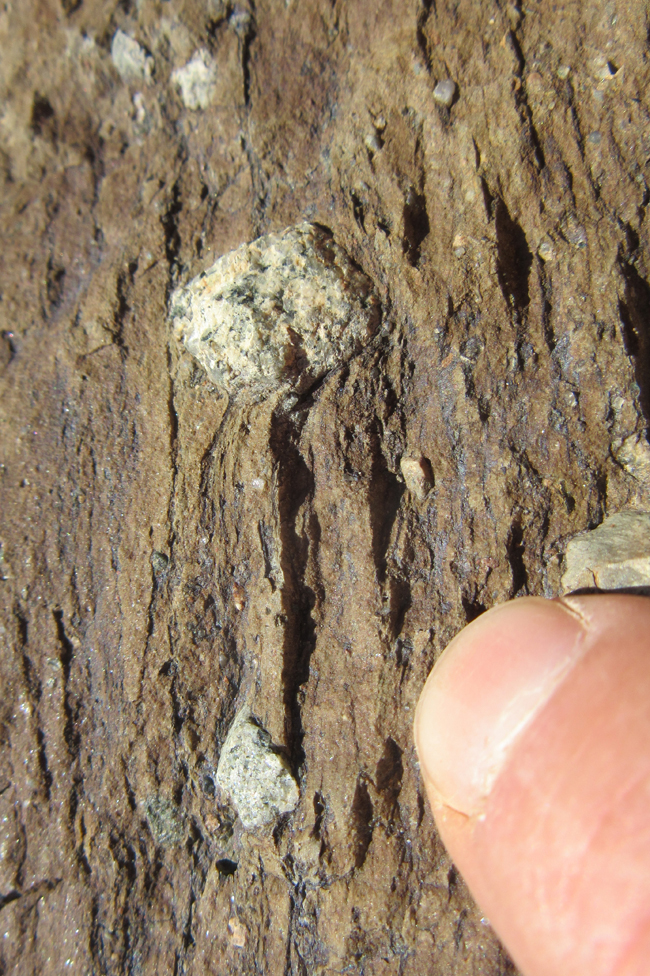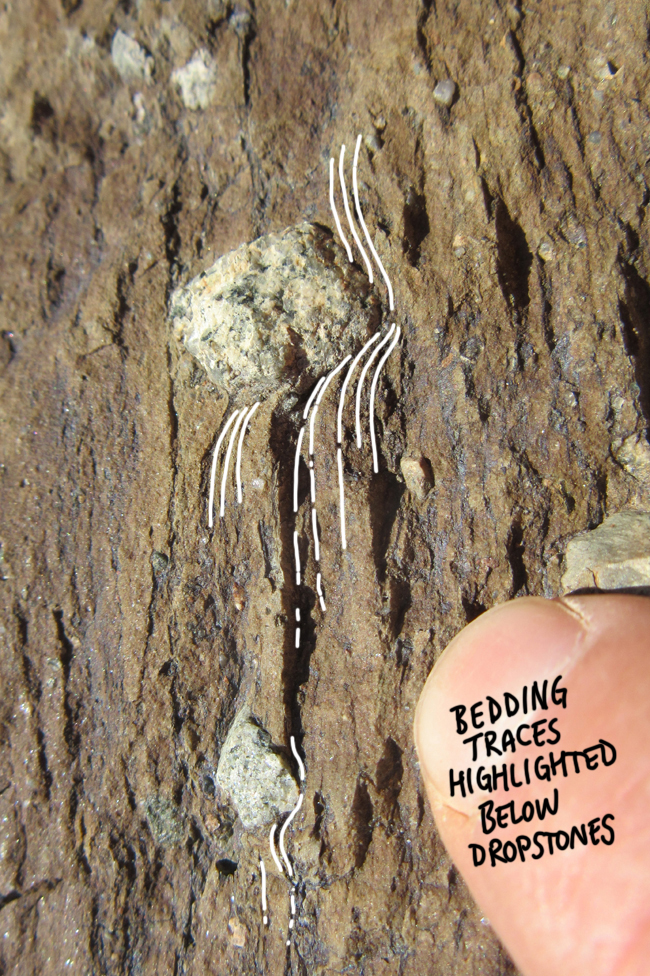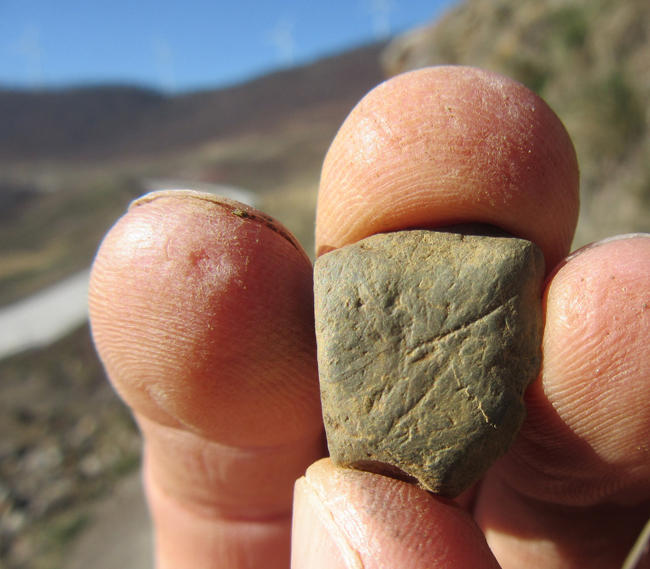I have known for a long time about a diamictite in the latest Devonian part of the Appalachian stratigraphic sequence, since it is exposed in the lowermost part of the section (western end of the outcrop) at Sideling Hill, Maryland. When I led field trips there, I talked students through the multiple possible origins for diamictites (sedimentary rocks that are poorly sorted, with significantly “outsized” clasts “floating” in a finer-grained matrix): they could be glacial in origin, or they could be mass wasting deposits, like those that result from submarine debris flows.
When they opened up a new section of the superhighway-to-nowhere, Corridor H, in West Virginia, a couple years ago, one of the road cuts revealed another exposure of this curious unit. For me, this triggered a renewed interest in the Spechty Kopf diamictite. I now had a name to put to it*, and I was eager to read that David Brezinski of the Maryland Geological Survey interpreted the Spechty Kopf as glacial in origin. He had some good evidence in the paper: (1) dropstones that clearly truncate sedimentary laminations, and (2) faceted and striated clasts. Until just recently, I hadn’t seen those for myself… but I was out at the new outcrop for a day of field work during the week of Thanksgiving, and was able to spend an hour looking at the unit.I found several things that convinced me that glaciation had a role to play in the deposition of the diamictite.
Here’s a typical look at its poorly sorted nature, and the angular / faceted shape of some of its large clasts:

There are two distinct sedimentary textures to this unit: a laminated subunit with outsized dropstones, and a massive unit with no internal layering. The image you just looked at is from the massive subunit. Everything else in this post is from the more interesting laminated subunit:
A big, oblong granitic clast (between my index finger and thumb), cutting across laminations:

Another, rusty orange on its exterior:

Some of the best views of the relationship between the outsized clasts and the laminations were not found in outcrop, but in float piled up at the base of the outcrop. Here’s my favorite example:

Zooming in on the most prominent two granitic clasts:

…And with the trace of bedding highlighted, showing the truncating relationship these pebbles have with their matrix. I am confident in identifying these as dropstones, based on the way they appear to squish down into the laminations:

That’s key, for me. Massive diamictites may be due to glacial deposits or to debris flows, but dropstones are a surer indication of glaciation. However, it should be noted that these strata are Devonian, and that plants had evolved by the Devonian. Therefore, at the time these strata were deposited, there existed more than one mechanism to raft big clasts of rock out over fine-grained deposits of mud: it could be icebergs, but it could also be sedimentary particles caught in plant roots. There are carbon films of plant fossils in this unit, and I’ve also seen fern fronds preserved as impressions.
The real prize find of the day was a single clast (a pebble) that showed both a faceted shape and striations on the facets. Here it is:



Plants can’t be held responsible for that! These scratches are strongly suggestive of glaciation.
I think the Spechy Kopf diamictite may be the most interesting unit in the Paleozoic sequence in the Appalachian basin. More on it later…
__________________________________________
* The name comes from the type locality, near a mountain in Pennsylvania with a name that’s German for “Woodpecker head.”

There were a couple of things that struck me about this post.
1. The stones appear to be confined to a horizon, so they were deposited in an event. It was not an ongoing process.
2. They’re similar size, not widely varying in size, which is a what a random selection would produce. They’re sorted, in other words.
3. They’re not rounded. Even fine surface markings are preserved. So they didn’t spend much time in a river or creek.
What might produce this result is a melt-off event. Hydraulically sorted, but all at once and very quickly. Carried in a turbid flow and dropped in place, where they were cemented.
Also, kudos to picking up on all these tiny, telltale details.
Thanks for the thoughtful read!
By “stones,” I presume you mean clasts. This unit, the Spechty Kopf diamictite, is a regionally extensive unit. So if your “event, not ongoing” hypothesis is correct, it needs to account for that wide area over which that event operated (see the Brezinski paper for a map).
The size varies from fist-sized to clay.
Second point on that topic: an ongoing process would better explain the internally layered subunit (e.g. http://gigapan.com/gigapans/162387 ) but an instantaneous event would better explain the massive subunit (e.g. http://gigapan.com/gigapans/162809)
Some clasts are well rounded, but some are not – both clast morphologies can result from glacial processes. The signature of glaciation however, is faceted and striated clasts. Remember that the actual event doesn’t need to be all one thing or all another. There could be water-borne cobbles tumbling along as icebergs carry angular /striated clasts overhead.
Amazing how much these rocks look like the “Mt. Rogers” facies (forgot what they call that now). The dropstone and the striations that you capture are sure big selling points. But, wow, 30 degr. south of the Late Devonian Equator, and knowing what came before and after makes it pretty mind-boggling. You could believe it taking place at that latitude in the Late Proterozoic, but Late Devonian? Wow! – But, it is what it is. What a great place for students!